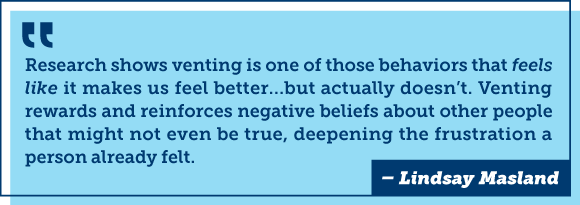There’s no job more people-oriented than teaching. And though working with people (especially little people) can bring a ton of joy, it can also bring stressors and emotional challenges not found in other professions. The question is: What do you do about it?
We know you love your students, but it can be tempting to complain about their behaviors sometimes. Let’s look at the upsides and downsides of complaining, and how to do it right.
Three Types of Complaining
Not all complaining is created equal. Before addressing complaining in teaching specifically, let’s look at the different types of complaining. Which one do you see yourself doing most often?
- Chronic: When we practice certain habits or thought patterns over and over again, we can actually “rewire” our brains to follow these patterns when similar situations come up. Unfortunately, the same is true with complaining. The act of complaining can become more of a ritual than a genuine emotional response to a negative situation. This type of chronic complaining is not healthy and leads to focusing on lamentation over problem solving.
- Venting: Venting tends to be focused on oneself and one’s emotions. Venters are seeking validation and sympathy for their anger, worry, sadness, disappointment, or frustration. When we’re in this mode, we’re not likely to listen to advice or look for a solution. We just want to be heard.
- Instrumental: This healthiest version of complaining prioritizes finding a solution to a problem that has created emotional stress. Instead of dwelling on negative emotions, instrumental complaining points out a tangible problem, focuses on the impact and need for change, and lays out a specific goal to make the problem right.
Unfortunately, in practice, instrumental complaints represent only 25% of the complaints people voice; the rest are unhealthy forms. We’ll get into more details about how to complain in a healthy way later in this article.

Is Venting About Students Worth It?
Of all the types of complaining, venting is the one we hear about most. After all, we want to be authentic and don’t want to bottle up our emotions. So a little venting is good, right?
It turns out that might not be the case. Venting—that is, expressing negative emotions with no intention of finding a solution—actually ends up having the opposite effect we might hope. According to Lindsay Masland, a professor of psychology and assistant director for faculty professional development at Appalachian State University:
Research shows venting is one of those behaviors that feels like it makes us feel better…but actually doesn’t. Venting rewards and reinforces negative beliefs about other people that might not even be true, deepening the frustration a person already felt.
Other studies show that when one person complains, both the speaker and the listener’s moods are worse afterward. So much for getting something off your chest to feel better! In fact, further research shows that in general, happy people complain less and are more mindful about the words they say.
Masland goes on to suggest that instead of jumping to conclusions about students’ behaviors, teachers can take a more academic approach and “hypothesis-test” their ideas about why students are acting a certain way. “Sure,” she says, “hypothesis one could be that the student is a horrible person, fine. But what are the other hypotheses?”
Healthy Complaining for Teachers
Okay, so aimless venting doesn’t help, nor does chronic complaining. But what about that third, healthy type of complaining, instrumental complaining? Veteran educator Suzanne Capek Tingley gives six important considerations and boundaries for when you’re ready to share some of the tough stuff you’re facing in the classroom.
- Choose the right audience. If you’re honest with yourself, you know who’s going to respond well to complaining and who’s not. You know who’s just going to egg on negativity and who’s likely to repeat what you said to the wrong people. Avoid such confidants. Instead, seek out trusted colleagues or family members who will listen, sympathize, and point you down a more positive path.
- Keep conversations private. Obviously there are listening ears everywhere at school, but public places—especially if you live in a small town—aren’t immune to eavesdroppers who may or may not have a connection to your school. Keep your conversations as private as possible to protect people’s privacy and prevent the possibility of your words being taken the wrong way or out of context.
- Keep names out of it. Education author Michael Linsin recommends never mentioning a student by name (unless you’re in a formal meeting concerning the student). Chances are, if you’re talking to a colleague, he or she is going to know who you’re talking about. However, it’s not fair to color others’ opinions negatively before they’ve ever met your student. After all, that student might be in their class one day.
- Avoid “anonymous” online complaints. Let’s face it: There’s nothing beneficial about posting negative things about students online. It’s unprofessional, unkind, and goes against everything we teach students about not bullying. Plus, there’s never a guarantee that your comments will remain private or anonymous, and you’re putting your job at risk by posting in the first place.
- Be positive and solution-focused. Working through frustrations doesn’t have to be negative. In fact, if you’re only out to unload negative feelings, you’re creeping back toward unhealthy venting or even chronic complaining. Instead, when you share problems, be on the lookout for solutions and seek out people who will help you renew your mind and your emotions so you can face the problem in a more positive way.
- Find alternatives to complaining. Sometimes, not saying anything at all might be the best way to let go of negative feelings. Instead, try to remove yourself from the situation and get some perspective by taking a walk, going out to dinner, or spending time with your family. Hopefully, your frustrations will melt away. But if they’re still there the next morning, then you can consider reaching out for additional help. (More on that in the next section.)
How to Tell When Healthy Complaining Is Appropriate: The Five Ws
So how do you know when it’s time to speak up and when you might need to take a beat? Psychology Today suggests working through the “five Ws of venting” when you feel the urge to complain about something difficult:
- Wait: There’s a difference between reacting and responding. Reacting is your knee-jerk emotional answer to something that happens to you. Responding, on the other hand, means taking a moment to consider your emotions and decide whether they’re worth acting on. Sometimes, instead of reacting to a student’s actions by reflexively complaining, it’s better to take a moment and consider what the best response really is.
- Why: It’s human nature to fill in information about a situation and categorize it accordingly. A student with strong family support didn’t apply himself yet again? It’s tempting to assume the student must be choosing to be lazy, but before running away with that conclusion, take a few moments to brainstorm other reasons why this might be happening. Doing so might diffuse your urge to complain and even lead to some new ideas to solve the problem.
- Who: Schools are delicate ecosystems. Changes in rules, funding, or pedagogical approaches for one teaching team can create envy or concern all throughout the school. However, before you start complaining or gossiping, take a moment to consider: Does this really involve or affect me? Should I really spend my time and emotional energy talking about this?
- Write: We know that venting leaves both parties in a worse mood than before. So instead of immediately creating a situation that might dampen everyone’s emotions, consider getting it out on paper first. Write or type out what you’re angry or frustrated about and why. Doing so might help you work through the emotions—and maybe even start to come up with solutions. (Just make sure to burn or delete your letter afterward. 😊)
- Witness: If your emotions persist after taking all of these steps, then maybe it’s time to talk to someone else. But make sure to set up limits for yourself and ask the other person to enforce them. For example, you might ask your friend to (a) hold you to a time limit, (b) not allow you to repeat the same information when it’s not helpful, and (c) prompt you to articulate a solution or lesson learned at the end.






